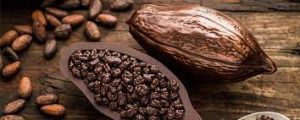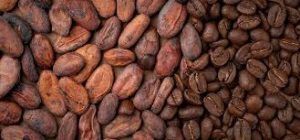Cocoa nibs are cocoa beans that have been refined, roasted and crushed. Cocoa seeds are not crushed into powder, namely crushed, obtaining sufficiently large elements. Cocoa nibs have a dark brown “chocolate” color, a rich smell of bitter chocolate and a slightly bitter taste. Store cocoa beans in a dry, well-ventilated place out of direct sunlight. The product retains its useful and organoleptic properties for a year after the date of manufacture.
Calorie cocoa nibs
The calorie content of cocoa nibs is 607 kcal per 100 grams of product.
The composition and useful properties of cocoa nibs
The composition of the product: crushed cocoa beans, does not contain preservatives, food colors and GMOs. Thanks to the theobromine contained in the product, dishes and drinks made from cocoa nibs have a stimulating and stimulating effect (calorizator). Cocoa nibs contain fiber that improves intestinal motility, vitamins, minerals and antioxidants. The product does not contain allergens.

Harm of cocoa nibs
Due to the high calorie content of the product, you should not get carried away with cocoa nibs, so as not to gain extra pounds. Excessive consumption of cocoa nibs can cause problems with the cardiovascular system, increased blood pressure and trouble in the digestive tract.
Cocoa nibs in cooking
The traditional use of cocoa nibs is to make a drink that tastes more like hot chocolate than regular cocoa. Before brewing cocoa, it is recommended to grind the cocoa nibs a little with a coffee grinder so that the aroma and taste of the drink become richer. You can cook cocoa with milk, water, or a combination of both, adding spices and sugar to taste. Cocoa nibs are used to make various desserts, pastries, confectionery, sweets, ice cream, dessert decorations, hot drinks and alcoholic cocktails.
Cocoa beans
Calories, kcal: 565
Proteins, g: 12.8
Fats, g: 53.1
Carbohydrates, g: 9.5
Cocoa beans are the seeds of the fruit of the cocoa tree, they are almond-shaped, placed in a pod in five rows, tightly adjacent to each other. The fruits grow directly on the trunks of evergreen trees native to Central America. A drink made from cocoa beans was known long before our era, the taste was bitter, but it gave an incredible burst of energy.
Currently, cocoa beans are grown in Africa, South America, Indonesia. The main suppliers of fresh cocoa beans are Côte d’Ivoire, Peru, Colombia and Malaysia (calorizator). The Forastero cocoa bean variety is considered the least whimsical, but very productive. The Arriba, Criollo and Trinitario varieties have a richer taste without bitterness, but caring for the trees of these varieties requires some effort.

The fashion for a “healthy” diet dictates its own rules, according to which it is simply vital to have “live” cocoa beans in your diet. It must be remembered that any cocoa beans brought legally must not go through the most useful way of disinfection, so it is not recommended to blindly follow the recipes of “eternal youth”. Cocoa beans undergo a mandatory fermentation process, the ability to germinate in them dies off, but the beneficial properties that have long been noticed and skillfully used are preserved.
Calories in cocoa beans
The calorie content of cocoa beans is 565 kcal per 100 grams of product.
Composition of cocoa beans
The chemical composition of cocoa beans includes: vitamins A, B1, B2, B5, B6, B9, B12, E, H and PP, as well as potassium, calcium, magnesium, zinc, selenium, copper and manganese, iron, chlorine and sulfur, molybdenum, cobalt, phosphorus and sodium.
Useful properties of cocoa beans
Cocoa butter and cocoa mass are obtained from cocoa beans, which improve blood circulation in the brain, which is an excellent prevention of strokes. The ability of cocoa to normalize blood pressure directly leads to a decrease in the risk of heart attacks (kalorizator). Cocoa beans contain antidepressants and antioxidants.
Cocoa beans in cooking
They learned how to cook delicious dishes from cocoa beans: hot chocolate, cocoa drink, cocktails, jelly, pastries. Cocoa butter and cocoa mass are added to milk porridges, puddings, desserts, and chocolate is also made.
